With the threat of the Japanese Navy eliminated, General Smith and his Fifth Amphibious Corps on Saipan were free to continue the fight without fear of being stranded. For Saitō’s men on the island, however, Ozawa’s defeat made their own eventual annihilation a fait accompli.
American strength would continue to build while the isolated Japanese force steadily weakened as it was ground down and destroyed. With no hope of reinforcements and resupply, the defenders resigned themselves to suffer the same end as would every Japanese island garrison across the Pacific unfortunate enough to have the weight of U.S. power come down on them with no line of retreat. All that remained was to fight as hard as they could and make the Americans pay for every inch of ground before selling their lives for their god-emperor.
This suicidal mindset would set the tone for nineteen days of combat to follow. There were no easy victories on these Pacific islands against an enemy that had been raised to give his life for his emperor without question and never surrender. Said Marine Rick Spooner: “Our principle objective was to stay alive ourselves. Not day-to-day but from one minute to the next.”

US Marines moving positions during battle in Garapan, during the Pacific Campaign of World War Two, Saipan, circa 1943-1945. (Photo by US Marine Corps/Getty Images)
With the entirety of the Fifth Amphibious Corps ashore, and U.S. warships once again cruising the waters off Saipan to add their air power and big guns in support, the Marines and soldiers embarked on pushing Saitō’s determined defenders off the island. Even with the awesome fire support from offshore batteries and strafing and rocket-firing fighter-bombers, progress was agonizingly slow. The determined Japanese infantry contested every hill, every field, every little town, every ravine and cave using cover to mask machine gun nests, pillboxes, and snipers while their artillery lobbed in shells from protected positions on the other side of steep limestone ridges. And civilians caught in the cross-fire added another dimension of difficulties for the Americans.
U.S. planners had originally scheduled the next phase of the Marianas campaign, the capture of Guam, for June 18. Because of the unexpected resistance on Saipan, however, that timetable was scrapped as the true nature of the bloodbath ashore was revealing itself. The Guam invasion was postponed until July 21.
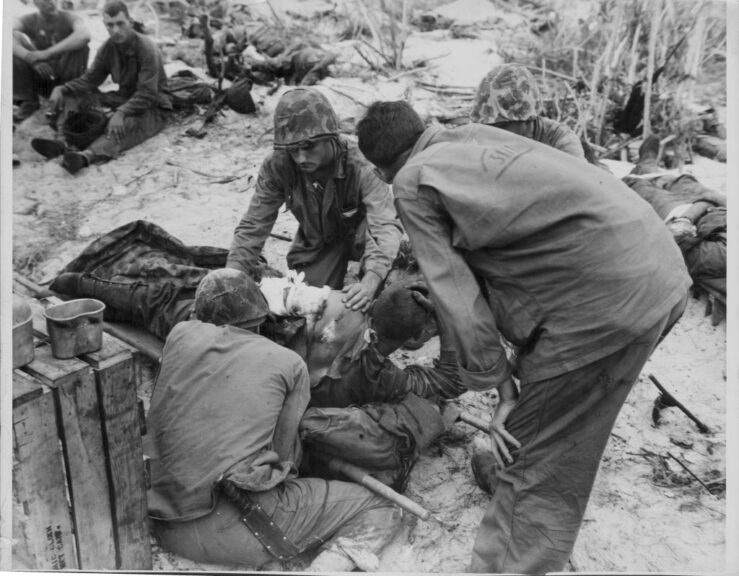
US Navy Corpsman tending to injured soldiers during the Pacific Campaign of World War Two, Saipan, circa 1943-1945. (Photo by US Marine Corps/Getty Images)
Throughout the rest of June and into July, under a baking sun and often short of water, the Americans on Saipan fought their way northward towards the neck and head of the dinosaur. While the 2nd and 4th Marine Divisions moved up the left and right side of the island respectively, the Army 7th Division pushed up the center.
Progress was agonizingly slow. Fighting was especially brutal and prolonged around Mount Tapochau with artillery raining down from its slopes into the valleys where the Americans gave the surrounding battle sites names like “Death Valley” and “Purple Heart Ridge.” But the fighting continued. Said 2nd Marine Kenneth Killilea, “There was bayonets, there was K-knives, there was butts of rifles, it was fight and counter-fight all the way to the end.” Marines finally stormed the summit on June 25, D+9, and beat off repeated Japanese attempts to retake Saipan’s highest point.
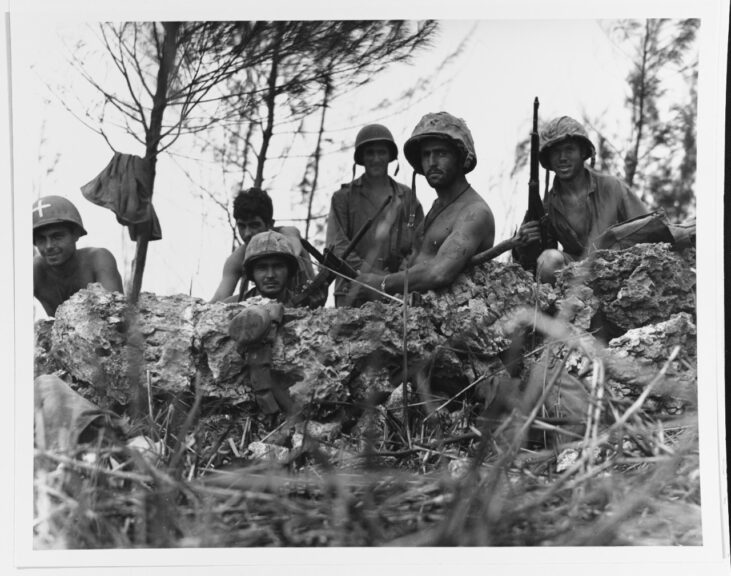
Saipan Operation, June 1944. Marines pose in a foxhole near the Saipan front lines, 1 July 1944. Photo by USS INDIANAPOLIS. Note tattoo on man 2nd from right. National Archives. Naval History and Heritage Command.
By July the remaining Japanese resistance began to crumble as the defenders were being squeezed into the northern tip of the island. Saitō decided the situation was hopeless and sent out orders for the remainder of his forces to perform gyokusai, one final suicide attack to destroy as many of the enemy as possible before dying. He then committed ritual suicide.
In the pre-dawn darkness of July 7, an estimated 4,000 Japanese shouting “Banzai!” wielding rifles, swords, bayonets and knives charged in waves towards an encampment of soldiers and Marines near Tanapag Harbor. They overran several positions, including the 105th Infantry Regiment command post, killing or wounding over 1,000 Americans in often hand-to-hand combat before being beaten back with point-blank machine gun fire and artillery. It was the largest Banzai charge of the war. The attackers were killed to a man.
Spooner contemplated the grisly aftermath of the enemy corpses baking in the tropical heat: “There were places where they were piled three and four high as they tried to advance over their dead.”
But as awful as the night of the 7th was, had the Japanese remained in their positions to be rooted out one by one, as would happen later on Peleliu, Iwo Jima and Okinawa, the final tally in U.S. casualties would have no doubt been much higher. This final desperate gesture of the Samurai spirit effectively ended organized resistance on Saipan. On July 9 the island was officially declared “secured.”
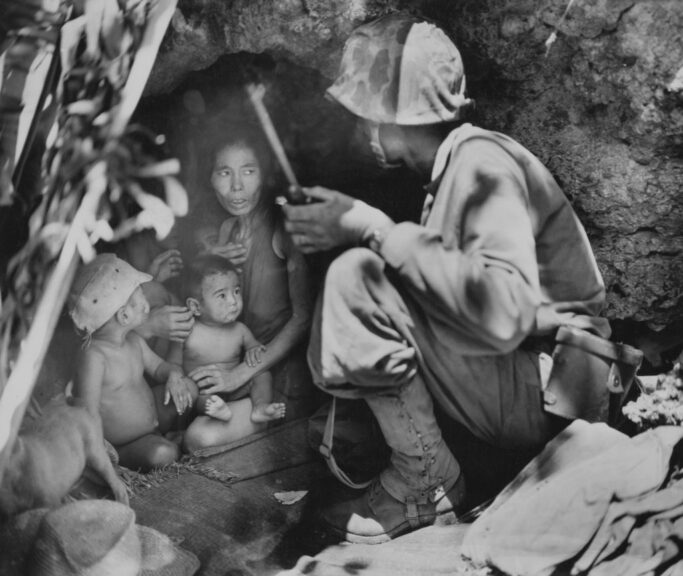
First Lieutenant Robert B Sheeks, a combat Intelligence and Japanese Language Officer with the 2nd Marine Division of the United States Marine Corps talks with a Chamorro woman and her children. US Marine Corps Official Photo. (Photo by Angus Robertson/FPG/Archive Photos/Getty Images).
One final horror remained. At the cliffs of Marpi Point on the northern tip of the island the Americans witnessed a tragedy. The Japanese military had brainwashed the island’s inhabitants into believing that if taken by the American “devils” they would be raped, tortured, and murdered and their babies eaten. Over loudspeakers interpreters tried to assure the terrified civilians they’d be treated humanely.
Some did come over to U.S. lines where food, medical attention and kindly treatment greeted them. But, sadly, many were not persuaded. The Americans, many still teenagers, watched helplessly as some 1,000 civilians chose to commit suicide by leaping to their deaths to the rocky shore 600 feet below. Some mothers first tossed their babies before taking the death plunge themselves. For many a Marine and soldier hardened by weeks of brutal combat, this was the nightmare that would stay with them for the rest of their lives.
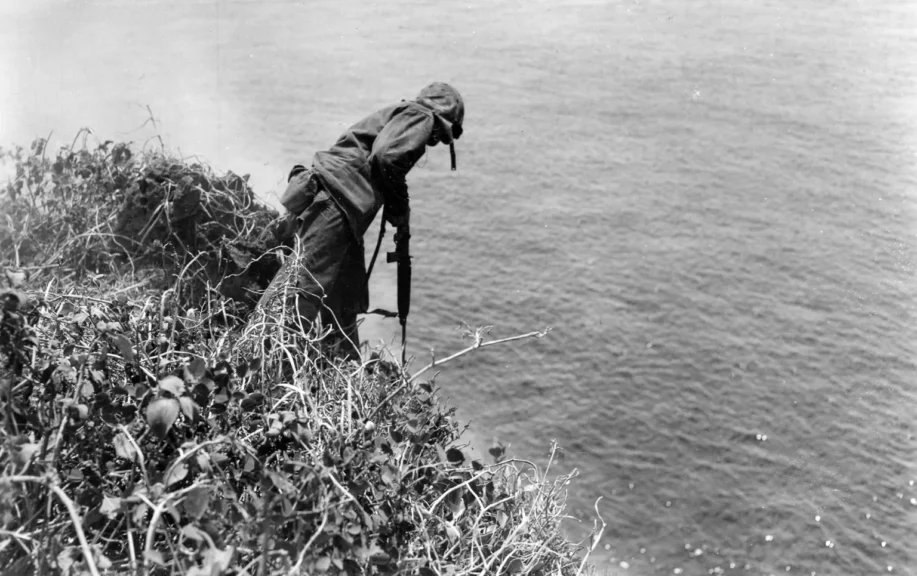
“Into The Sea.” USMC photo by Sgt. R. B. Opper. Courtesy: 1-24thmarines.com
For the Americans, Operation Forager was an ominous harbinger of the battles to come. In 25 days of combat the U.S. lost some 3,200 killed and another 13,000 wounded. Of the 31,000 Japanese defenders, only 1,800 were taken prisoner (half of them Korean laborers). Thousands of civilians also lost their lives being cut down in the fighting itself or by suicide.
As noted, the invasion of Saipan had been the largest amphibious operation of the Pacific War to date. That it took place just nine days after the massive Normandy landings in France on the other side of the world was a testament to the growing might of a United States now fully mobilized for war. What this heralded for the Japanese war effort was not lost on Tokyo.
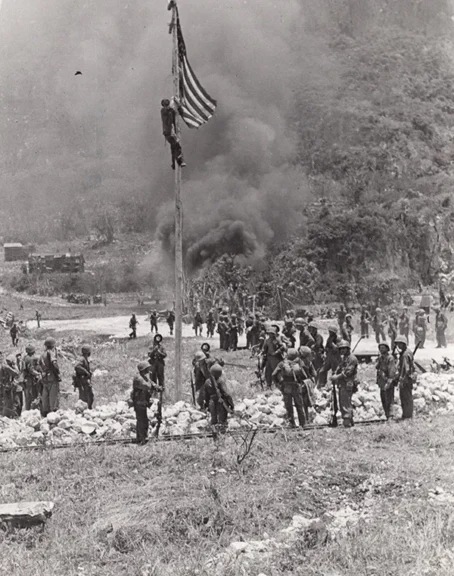
Raising the flag at Marpi airfield, 9 July 1944. USMC photo by Sgt. Nick Ragus. Courtesy: 1-24thmarines.com
As expected, the loss of Saipan, and the subsequent capture of Guam and Tinian after more bloody fighting, prompted Emperor Hirohito to withdraw his support for Tojo’s government which fell out of power. For the Japanese civilians on the home islands, the Marianas campaign initiated a new and much deadlier phase of the war. Once captured, USAAF and Navy engineers constructed six massive airfields on the newly acquired Marianas capable of fielding hundreds of massive B-29s.

Two U.S. soldiers watching the takeoff of a B-29 bomber from the air base at Saipan, destination Tokyo. Saipan, 23rd November 1944 (Photo by Mondadori via Getty Images)
On November 24, 1944, the first Superfortresses took off from the islands to raid Japan now just 1,200 miles away. Within a few months hundreds of bombers per mission were flying from the new bases to devastate the home islands. On the night of March 9-10, 1945, over 300 B-29s from Saipan firebombed Tokyo, killing an estimated 100,000 residents and burning out fourteen square miles of the city, earning it the gruesome distinction of being the single deadliest event in the history of warfare. By war’s end anywhere from 200,000 to 500,000 Japanese civilians would die in the unrelenting bombings, along with five million made homeless. At least 40% of over 60 of Japan’s cities were burned out; the nation’s capacity to wage war eventually ceased to exist. And finally as if to fully express what the loss of the Marianas signified, the B-29s Enola Gay and Bockscar which dropped the atomic bombs that obliterated Hiroshima and Nagasaki respectively flew from Tinian island.
Before the Americans took the Marianas, for the Japanese populace the war had been a distant spectacle. Afterwards, hell would come to their doorsteps, and an already brutal Pacific War would escalate to a new strata of violence. Due in large part to the rain of fire coming out of the Marianas, Japan’s nightmare finally came to a merciful end in September 1945 when a victorious American fleet, including many warships that participated in the epic Battle of the Philippine Sea, sailed into Tokyo Bay.
Considering the violence and hatred expressed on battlefields like Saipan, one hopes that those who fought there 80 years ago did not do so in vain. Indeed, as per Supreme Commander for the Allied Powers, Gen. Douglas MacArthur upon accepting Japan’s formal surrender: “It is my earnest hope, and indeed the hope of all mankind, that a better world shall emerge from the blood and carnage of the past.” Perhaps, in the end, this was what Saipan and all the bloody battles of the Pacific that marked the way to that moment were all about.
* * *
RELATED: The Battle Of Saipan, Part One: Invasion
RELATED: The Battle Of Saipan, Part Two: The Great Marianas Turkey Shoot
RELATED: The Battle Of Saipan, Part Three: Mission Beyond Darkness
* * *
Brad Schaeffer is a commodities trader, columnist, and author of two acclaimed novels. Along with Daily Wire, his articles have appeared in the Wall Street Journal, New York Daily News, New York Post, National Review, The Federalist, The Hill and other media outlets. His newest book, LIFE IN THE PITS: My Time as a Trader on the Rough-and-Tumble Exchange Floors, is a fun and informative memoir of his time as a floor trader in Chicago and New York. You can also find more of Brad’s articles on Substack.
The views expressed in this piece are those of the author and do not necessarily represent those of The Daily Wire.

Continue reading this exclusive article and join the conversation, plus watch free videos on DW+
Already a member?


